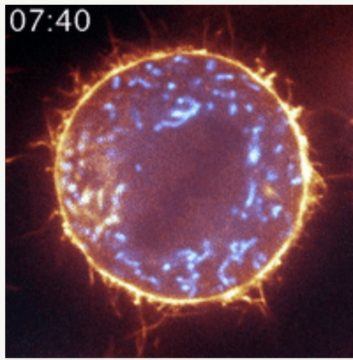From Penn Medicine News:
 In a landmark study, a team led by researchers at the Perelman School of Medicine at the University of Pennsylvania has discovered—and filmed—the molecular details of how a cell, just before it divides in two, shuffles important internal components called mitochondria to distribute them evenly to its two daughter cells.
In a landmark study, a team led by researchers at the Perelman School of Medicine at the University of Pennsylvania has discovered—and filmed—the molecular details of how a cell, just before it divides in two, shuffles important internal components called mitochondria to distribute them evenly to its two daughter cells.
The finding, published in Nature, is principally a feat of basic cell biology, but this line of research may one day help scientists understand a host of mitochondrial and cell division-related diseases, from cancer to Alzheimer’s and Parkinson’s.
Mitochondria are tiny oxygen reactors that are crucial for energy production in cells. The Penn Medicine team found in the study that a protein called actin, which is known to assemble into filaments that play a variety of structural roles in cells, also has the important task of ensuring an even distribution of mitochondria prior to cell division. Thanks to this system, the two new cells formed by the division will end up with approximately the same mass and quality of these critical energy producers.
More here.
